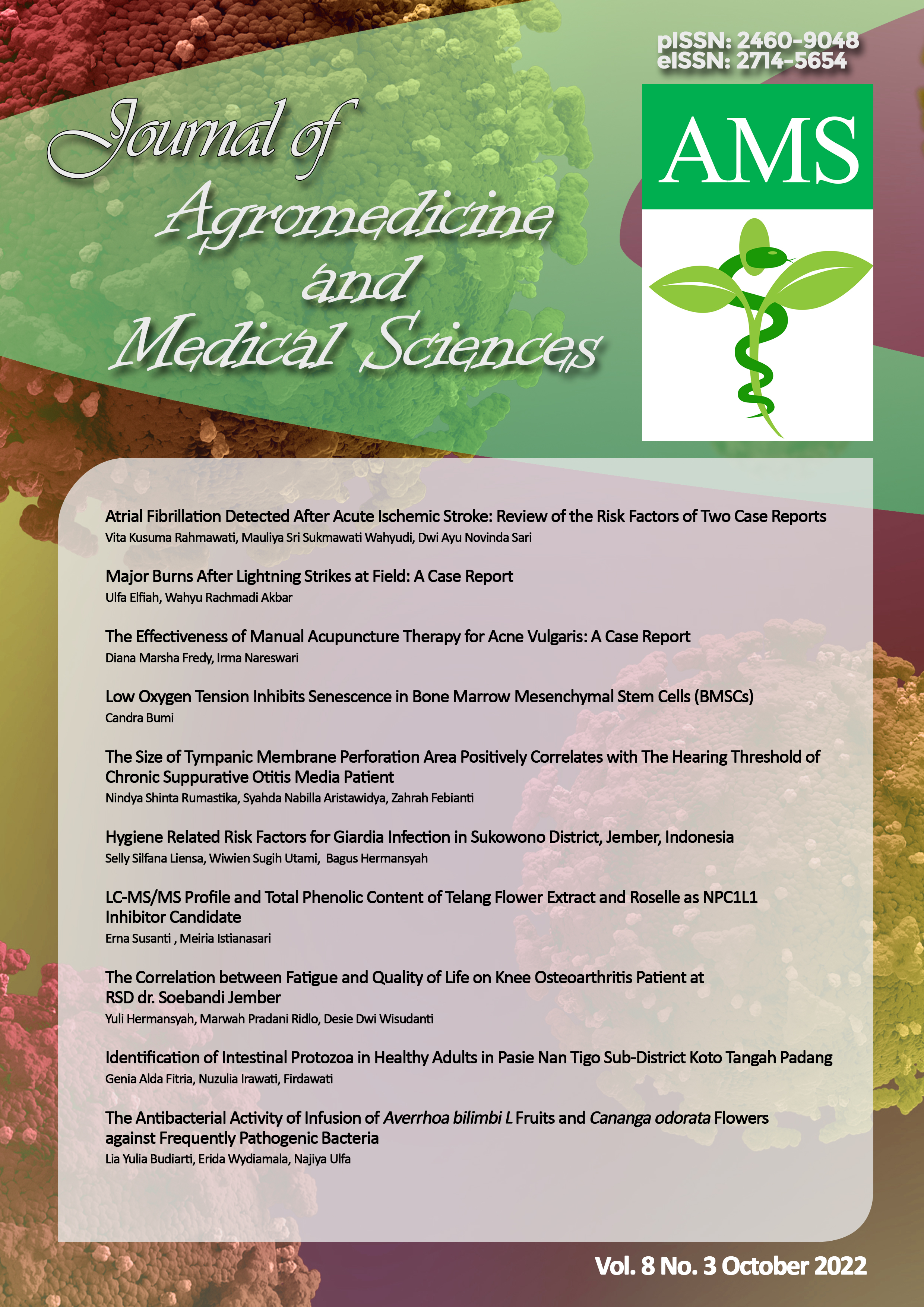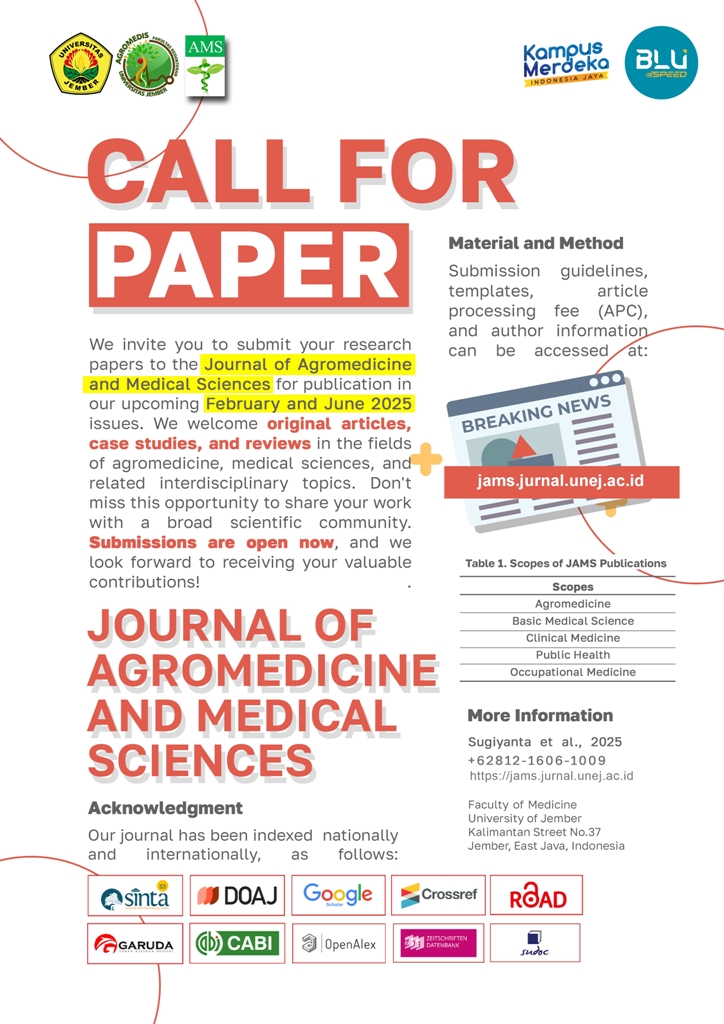Atrial Fibrillation Detected After Acute Ischemic Stroke
Review of the Risk Factors of Two Case Reports
DOI:
https://doi.org/10.19184/ams.v8i3.34235Abstract
Atrial fibrillation (AF) increases 4-5 times incidence of cardiac embolic stroke. In contrast, as many as 70% of AF cases can be detected in stroke within three days of onset, and this can affect the patient's prognosis. This case report describes the causal pathophysiology of AF and acute stroke and identifies the associated risk factors. Case 1 is a 44-year-old woman, acute stroke with acute decrease level of consciousness. The patient came with status epilepticus and a hypertensive emergency. Obtained a history of stroke, uncontrolled hypertension, and myocardial infarction. Initial Score National Institutes of Health Stroke Scale (NIHSS) was 33 and CHA2DS2-VASc was 5. Investigation non-contrast head Computed Tomography (CT) scan showed no bleeding and echocardiography (ECG) showed AF with rapid ventricular response. The patient died after 3 days of treatment. Case 2 is an 83-year-old woman, acute stroke with acute decrease level of consciousness and right motor lateralization. There was a history of hypertension and stroke with left hemiparesis. The initial NIHSS was 28 and CHA2DS2-VASc was 6. Investigations non-contrast head CT scan showed no bleeding and ECG showed AF with normal ventricular response. The patient was discharged from the hospital after being treated for 22 days with NIHSS of 20. Several risk factors for post-stroke AF are elderly, hypertension, subtype of ischemic stroke, prior stroke, and comorbidities such as DM and hypertension. Post-stroke AF can occur because of changes in heart rhythm through autonomic disorders, increased plasma catecholamine levels, and inflammatory reactions. Early Recognition of risk factors, focusing on patients at higher risk of AF detected after stroke becomes important for comprehensive management of stroke with AF.
Keywords: acute ischemic stroke, atrial fibrillation, CHA2DS2-VASc score, risk factors.
Downloads
References
Carrazco, C., Golyan, D., Kahen, M., Black, K., Libman, R. B., & Katz, J. M. (2018). Prevalence and risk factors for paroxysmal atrial fibrillation and flutter detection after cryptogenic ischemic stroke. Journal of Stroke and Cerebrovascular Diseases, 27(1), 203-209. https://doi.org/10.1016/j.jstrokecerebrovasdis.2017.08.022
Chou, P. S., Ho, B. L., Chan, Y. H., Wu, M. H., Hu, H. H., & Chao, A. C. (2018). Delayed diagnosis of atrial fibrillation after firstâ€ever stroke increases recurrent stroke risk: a 5â€year nationwide followâ€up study. Internal Medicine Journal, 48(6), 661-667. https://doi.org/10.1111/imj.13686
Flach, C., Muruet, W., Wolfe, C. D. A., Bhalla, A., & Douiri, A. (2020). Risk and Secondary Prevention of Stroke Recurrence. Stroke, 51(8), 2435–2444. https://doi.org/10.1161/STROKEAHA.120.028992
Fridman, S., Jimenez-Ruiz, A., Vargas-Gonzalez, J. C., & Sposato, L. A. (2022). Differences between atrial fibrillation detected before and after stroke and TIA: a systematic review and meta-analysis. Cerebrovascular Diseases, 1-6. https://doi.org/10.1159/000520101
Go, A. S., Reynolds, K., Yang, J., Gupta, N., Lenane, J., Sung, S. H., ... & Solomon, M. D. (2018). Association of burden of atrial fibrillation with risk of ischemic stroke in adults with paroxysmal atrial fibrillation: the KP-RHYTHM study. JAMA cardiology, 3(7), 601-608. https://doi.org/10.1001/jamacardio.2018.1176
Grond, M., Jauss, M., Hamann, G., Stark, E., Veltkamp, R., Nabavi, D., Horn, M., Weimar, C., Köhrmann, M., Wachter, R., Rosin, L., & Kirchhof, P. (2013). Improved detection of silent atrial fibrillation using 72-hour Holter ECG in patients with ischemic stroke: a prospective multicenter cohort study. Stroke, 44(12), 3357–3364. https://doi.org/10.1161/STROKEAHA.113.001884
Hannon, N., Sheehan, O., Kelly, L., Marnane, M., Merwick, A., Moore, A., & Kelly, P. J. (2010). Stroke associated with atrial fibrillation–incidence and early outcomes in the north Dublin population stroke study. Cerebrovascular Diseases, 29(1), 43-49. https://doi.org/10.1159/000255973
Johansen, O. E., & Tveit, A. (2017). Understanding modifiable risk factors for new onset atrial fibrillation: the knowledge gap is closing. AME Medical Journal, 2, 178–178. https://doi.org/10.21037/amj.2017.12.01
Kim, Y. H., & Roh, S. Y. (2016). The mechanism of and preventive therapy for stroke in patients with atrial fibrillation. Journal of Stroke, 18(2), 129. https://doi.org/10.5853/jos.2016.00234
Kishor, K., Bisht, D., & Kalra, S. (2019). Review Atrial Fibrillation Cardiovigilance in Atrial Fibrillation-Primordial to Quinary Prevention Intervention. European Journal of Arrhythmia & Electrophysiology,5(2). https://doi.org/10.17925/EJAE.2019.5.2.77
Kishore, A. K., Hossain, M. J., Cameron, A., Dawson, J., Vail, A., & Smith, C. J. (2022). Use of risk scores for predicting new atrial fibrillation after ischemic stroke or transient ischemic attack—a systematic review. International Journal of Stroke, 17(6), 608-617. https://doi.org/10.1177/17474930211045880
Kneihsl, M., Bisping, E., Scherr, D., Mangge, H., Fandlerâ€Höfler, S., Colonna, I., ... & Gattringer, T. (2022). Predicting atrial fibrillation after cryptogenic stroke via a clinical risk score—a prospective observational study. European Journal of Neurology, 29(1), 149-157. https://doi.org/10.1111/ene.15102
Lindberg, T. (2017). Arrhythmias in Older People: Focusing on Atrial Fibrillation. Epidemiology and impact on daily Life. Lund University: Faculty of Medicine.
Mozaffarian, D., Benjamin, E. J., Go, A. S., Arnett, D. K., Blaha, M. J., Cushman, M., & Turner, M. B. (2015). Heart disease and stroke statistics—2015 update: a report from the American Heart Association. Circulation, 131(4), e29-e322. https://doi.org/10.1161/CIR.0000000000000152
Palà , E., Bustamante, A., Pagola, J., Juega, J., Francisco-Pascual, J., Penalba, A., Rodriguez, M., De Lera Alfonso, M., Arenillas, J. F., Cabezas, J. A., Pérez-Sánchez, S., Moniche, F., de Torres, R., González-Alujas, T., Clúa-Espuny, J. L., Ballesta-Ors, J., Ribas, D., Acosta, J., Pedrote, A., Gonzalez-Loyola, F., … Montaner, J. (2022). Blood-Based Biomarkers to Search for Atrial Fibrillation in High-Risk Asymptomatic Individuals and Cryptogenic Stroke Patients. Frontiers in cardiovascular medicine, 9, 908053. https://doi.org/10.3389/fcvm.2022.908053
Pedelty, L., & Gorelick, P. (2013). Stroke risk factors: Impact and management. In M. Torbey & M. Selim (Eds.), The Stroke Book (pp. 332-346). Cambridge: Cambridge University Press. https://doi.org/10.1017/CBO9781139344296.022
Sposato, L. A., Chaturvedi, S., Hsieh, C. Y., Morillo, C. A., & Kamel, H. (2022). Atrial fibrillation detected after stroke and transient ischemic attack: a novel clinical concept challenging current views. Stroke, 29(2), e94-e103. https://doi.org/10.1161/STROKEAHA.121.034777
Sposato, L. A., Riccio, P. M., & Hachinski, V. (2014). Poststroke atrial fibrillation: cause or consequence?: critical review of current views. Neurology, 82(13), 1180-1186. https://doi.org/10.1212/WNL.0000000000000265
Tirschwell, D., & Akoum, N. (2021). Detection of subclinical atrial fibrillation after stroke: is there enough evidence to treat?. JAMA, 325(21), 2157-2159. https://doi.org/10.1001/jama.2021.7429
Wang, Y., Qian, Y., Smerin, D., Zhang, S., Zhao, Q., & Xiong, X. (2019). Newly detected atrial fibrillation after acute stroke: a narrative review of causes and implications. Cardiology, 144(3-4), 112-121. https://doi.org/10.1159/000502971
Yang, X. M., Rao, Z. Z., Gu, H. Q., Zhao, X. Q., Wang, C. J., Liu, L. P., ... & China National Stroke Registry II Investigators. (2019). Atrial fibrillation known before or detected after stroke share similar risk of ischemic stroke recurrence and death. Stroke, 50(5), 1124-1129. https://doi.org/10.1161/STROKEAHA.118.024176























